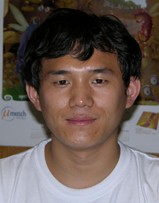 Contact Information
Contact Information
Jiangxi-OAI Joint Research Institute
3235 Nanjing Donglu
Nanchang, Jiangxi, 330047, China
Email: kidyxu@163.com
Education
- B.S. Bioengineering, Dept. of Bioscience & Engineering, Hebei University of Science and Technology (2004)
- M.S. Microbiology, School of Life Sciences, Nanchang University (2007)
- Ph.D. Food Science & Engineering, School of Life Sciences, Nanchang University (In Progress)
Projects
1. Screening and biological characterization of probiotic lactobacilli from women’s vagina
Predominated lactobacilli in vagina had been proved to be of utmost important for prevention of various urogenital infections and maintenance of the balance of vaginal microecosystem. Studies showed that lactobacilli might be the potential probiotic microorganisms using in the prevention and curing of bacterial vaginosis (BV). Up to now there were some commercial lactobacilli coming into being, which had been proved to be efficiency in the treatment of BV. In our studies the acidophilic strains were screened out from 162 vaginal samples of healthy pregnant women, and totally 326 strains of lactobacilli were obtained, among them 244 were hydrogen peroxide producing strains. The presence of lactobacilli on Hela cell line prevented the adherence of Candida albicans subsequently. Eleven probiotic strains were screened out of 326 lactobacilli mainly by their antagonistic potential against C. albicans, and partially by the antagonistics against Escherichia coli, Staphylococcus aureus and Pseudomonas aeruginosa and their adherence ability to Hela cells. 11 indigenous vaginal lactobacilli demonstrated stronger adherence and/or inhibitory function against pathogenic microorganisms, and could be used for candidate strains for development of vaginal probiotics.
2. Rapid detection of foodborne pathogenic microorganisms using nanomaterials
Increasing foodborne disease incidence over the last decades seems, in many countries, to be related to an increase in disease caused by microorganisms in food. This concern has been voiced in meetings of the Governing Bodies of both Organizations and in the Codex Alimentarius Commission. Traditional detection method is culturing, which is time assuming and low efficient. However, the important issue is to develop more efficient method to detect the pathogens in food. We combined the new nanotechnology and traditional immunological method, and developed a new method to detect the foodborne pathogens. Briefly, we synthesized surperparamagnet iron oxide nanoparticals and quantum dots, converted into water soluble, and then using conjugation technique to conjugate the nanopaticals with anti-bacterial antibody, and then we use a sandwich immune method to capture and detect those pathogens appeared in food. By using the new method, the detection time can be cut down significantly, and the sensitivity can be raised also.
Awards
- The 1st Prize of excellent paper in the 3rd Symposium of JXJWXH held in March, 2006 in Nanchang. The paper: Study on the physiological functions of edible fungi.
- The 1st level scholarship of Nanchang University in 2006.
- Invited oral lecturer of Oligo International Forum held in November, 2007 in Beijing.
Publications
- Hengyi Xu, Gang Yu, and Hua Wei. Study on the physiological functions of edible fungi. Jiangxi Journal of Traditional Chinese Medicine. 2005, 36(12):194-198.
- Gang Yu, Hengyi Xu, and Hua Wei. Study progress of anti-tumor active materials in edible fungi. Jiangxi Journal of Traditional Chinese Medicine. 2005, 36(12):190-192.
- Hengyi Xu, Hua Wei, and Ming Zeng. Detection of Bifidobacteria targeted on the 16S rRNA gene. Progress in Microbiology and Immunology (Chinese). 2006, 34(4):84-88.
- Hengyi Xu, Liang Guo, Ming Zeng, and Hua Wei. Progress in the study of vaginal lactobacilli. Food Science and Technology (Chinese). 2007, (10):173-178.
- Hengyi Xu, Liang Guo, Hua Wei, Ming Zeng, and Yonghua Xiong. Progress in the detection of Escherichia coli O157:H 7 in food. Proceeding of 5th CIFT conference. 2007.
- Hengyi Xu, Wanhong Tian, Lijun Jia, Lanyin Wang, Bocai Cheng, Cuixiang Wan, Ming Zeng, and Hua Wei. Antibiotic susceptibility of potential probiotic lactobacilli isolated from the vagina of Chinese pregnant women. BMEI (2) 2008: 838-842.
- Hengyi Xu, Wanhong Tian, Lijun Jia, Lanyin Wang, Jing Yuan, Chunmei Liu, Ming Zeng, and Hua Wei. Antagonistic potential against pathogenic microorganisms and hydrogen peroxide production of indigenous lactobacilli isolated from the vagina of Chinese pregnant women. Biomedical and Environmental Sciences. 2008, accepted.
- Bocai. Cheng, Shiliang Yang, Hengyi Xu, Jianshe Liu, Liang Guo, Hua Wei, Wanhong Tian, and Ming Zeng. Degradation of deoxynivalenol by Bacillus subtitlis ZZ and Bacillus licheniformis DY. Journal of Biotechnology. 2008, accepted.
- Hengyi Xu, Wanhong Tian, Shiliang Yang, Gang Yu, Ming Zeng, and Hua Wei. Screening and characterization of indigenous lactobacilli with probiotic properties from the vagina of Chinese pregnant Women. Journal of Biotechnology. 2008, accepted.
- Hengyi Xu. Genus Proteus. In Enterobacteriaceae. eds. Ming Zeng, et al. 2008.